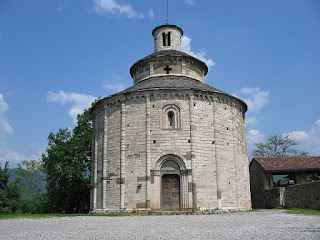One of Europe’s best preserved company villages
 |
| A view over the rooftops of Crespi d'Adda |
Bergamo offers visitors a feast of medieval history but for those interested in experiencing history of a more recent variety, a trip to the industrial village of Crespi d’Adda, which can be found about 20km (12.5 miles) southwest of the city, is something to consider.
Crespi d’Adda is one of the best preserved company villages - that is, a community built exclusively for the employees of a single business - in the whole of Europe.
It has been a UNESCO World Heritage site since 1995.
The village was the brainchild of Cristoforo Benigno Crespi, an industrialist from the town of Busto Arsizio, a textile centre on the road from Milan to Lake Maggiore. He was born 185 years ago today, on October 18, 1833.
 |
| The main entrance to Cristoforo Crespi's cotton mill |
In 1869, Crespi bought some land near the town of Capriate San Gervasio close to the convergence of the Adda and Brembo rivers on a low-lying plain that forms a peninsula known as the Isola Bergamasca or Bergamasque Island. He identified it as the ideal place to build a large cotton mill.
Crespi was a capitalist entrepreneur but also a firm believer in the idea that a happy workforce is a productive workforce and he decided that his factory would be at the heart of its own mini-town, with every facility their workers might need right on their doorsteps.
Therefore, after digging a canal to provide hydraulic power, he commissioned the renowned architect Angelo Colla to build not only a factory but houses, a school, a hospital, a wash house, a church, shops for groceries and clothes, a theatre and a social club. A public swimming pool was added later.
He and his son Antonio equipped the school with pens, pencils, exercise books and every other resource needed to educate their workers’ children and paid the salaries of the teachers.
 |
Crespi himself lived in a villa made
to look like a castle |
The houses were more English-looking than Italian style, arranging in neat rows, surrounded by gardens with vegetable plots. The streets were the first in Italy to be lit by public-funded electricity.
The church was a replica of the church of Santa Maria di Busto Arsizio, in the Crespi’s home town. In the cemetery attached, Cristoforo built a pyramid-shaped family mausoleum.
The Crespi family themselves, in keeping with their role of lords of the manor, lived in some style in a huge castle-like villa on the edge of the village. Other directors of the company were also provided with villas, albeit on a lesser scale.
Under their benevolent governance, however, the factory - itself a work of art, built in neo-medieval style with an imposing entrance and chimneys that resembled obelisks - managed to avoid the strikes and unrest that affected other parts of Italy’s industrial world.
Nowadays, although the factory remains, only a small part of it is used. The Crespis sold it in 1929 after the Great Depression hit them hard and though it continued as a textile factory until the beginning of the current century, production on a significant scale ceased in 2004.
Other aspects of Crespi d’Adda remain intact, however, and many of the current residents are descended from Cristoforo Crespi’s original employees.
 |
| Cristoforo Crespi, the factory owner |
Access to the village is limited. No traffic is allowed into the village during the afternoon in summer and there is no bus service. Tourist coaches are not allowed beyond a certain point.
However, Crespi d’Adda is very close to the towns of Capriate San Gervasio and Trezzo sull’Adda and is easily accessible on foot. The walk takes no more than 15 to 20 minutes and there is a footpath along the river Adda.
There are regular buses to Capriate and Trezzo sull'Adda from Bergamo. They are operated by the Locatelli Group and depart from the main bus station (across from the railway station). Most of the services are prefixed with the letter ‘V’ and the journey takes just over an hour. More information and departure times can be found
here.
(Photo credits: View over Crespi d'Adda by Dario Crespi; Factory building by Daniel Case; Crespi's villa by Ian Spackman)














